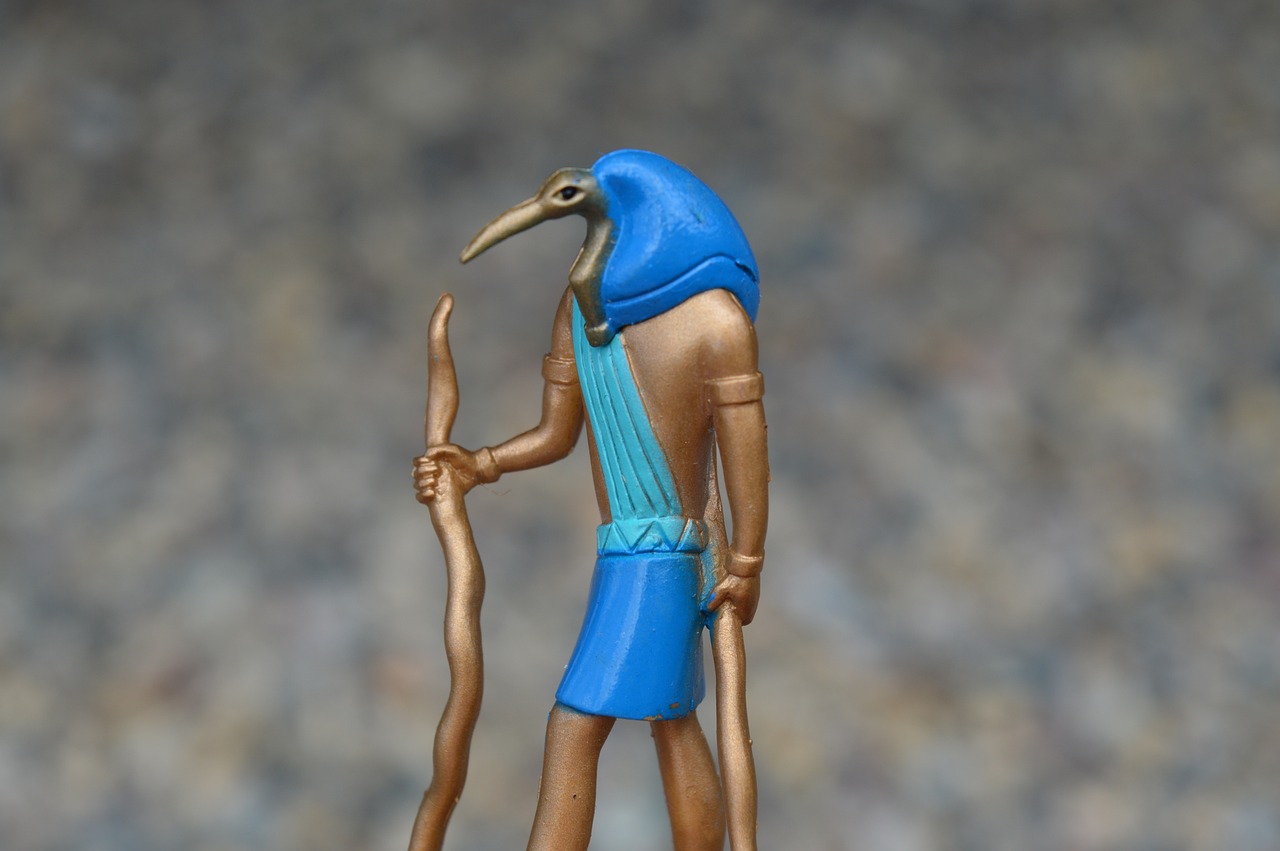Thoth: The Egyptian God of Wisdom and Writing
Thoth stands as the revered Egyptian deity associated with writing, wisdom, and magic. His influence extended to maintaining order and justice, serving as an advisor and mediator among the divine beings. As the protector of scribes, he was often depicted alongside his female counterpart, Seshat, the Goddess of writing and guardian of knowledge. While Thoth is credited with the creation of language, Seshat facilitated the dissemination of his words to humanity.
Dual Manifestations of Thoth
Thoth’s representations primarily include two forms: that of a baboon and an ibis. The baboon is typically shown as a seated figure adorned with a lunar disc and crescent on its head, occasionally wearing the Atef Crown, symbolizing his association with Upper and Lower Egypt. A notable artifact at the Hunt Museum features a baboon in a squatting posture, potentially embodying Thoth. These figures also symbolized the hours of night that the deceased traversed in the afterlife.
In his ibis form, Thoth is represented either as a literal ibis or, more commonly, as a human with an ibis head. Artistic depictions, such as one held at the Brooklyn Museum, display Thoth in this guise, emphasizing his significance in Egyptian culture.
Thoth as Mediator among the Gods
Thoth’s role as a mediator was critical among the Egyptian pantheon, often called upon to resolve disputes. A key myth reflects his involvement when Ra cursed his daughter Nut, prohibiting her from giving birth throughout the year. Thoth intervened by gambling with Khonsu, the Moon God, winning a fraction of the lunar light that allowed Nut to bear five children—Osiris, Isis, Geb, Nephthys, and Horus—thus extending the calendar from 360 to 365 days.
Following the tragic murder of Osiris by Set, Thoth played a vital role in assisting Isis in performing the rites necessary to revive her husband, bestowing upon her the mystical incantations that enabled Osiris to father Horus. Additionally, when the Goddess Tefnut abandoned Ra and retreated to Nubia, Thoth and Shu, disguised as baboons, were sent to coax her back, successfully restoring harmony and joy to Egypt.
Thoth’s Influence in the Afterlife
Thoth’s importance extended into the realm of the afterlife, where he assisted Osiris and Anubis in the Hall of Truth. He recorded the results of the heart’s weighing against the feather of Ma’at, determining an individual’s eligibility to enter the afterlife. As described by Joshua J. Marks, “His dwelling place in the afterlife, referred to as the Mansion of Thoth, served as a sanctuary for souls, where they could receive powerful spells to protect against the demons obstructing their path to paradise. His magical prowess was fundamental in revitalizing souls, enabling them to traverse the underworld.”
Worship of Thoth
Evidence indicates that worship of Thoth is among the earliest known in ancient Egyptian history, with roots tracing back to the Pre-Dynastic Period (6000-3150 BC). His veneration was embraced by subsequent royal families; during the Second Intermediate Period, the name Tuthmosis, which translates to “Born of Thoth,” appears multiple times in the records of the Pharaohs.
The oldest temple dedicated to Thoth can be found at Thoth Hill, within the Theban Necropolis. This site revealed three baboon statues alongside inscriptions bearing Pharaoh Mentuhotep II’s name (2055-2004 BC). Ongoing excavations of Amenhotep III’s funerary temple (1390-1352 BC) have unearthed two significant baboon statues that likely lined an avenue toward the temple, akin to the avenue of sphinxes that connects Luxor and Karnak. This Pharaoh also commissioned monumental 30-tonne statues of baboons in Hermopolis.
Thoth’s following transcended the elite; his cult center at Hermopolis drew in numerous pilgrims. Artifacts, including mummified ibises and baboons, were discovered nearby as offerings during festival celebrations, alongside stone statues similar to those found in the Hunt Museum. His images adorned the tombs of both Pharaohs and commoners, and amulets depicting Thoth, typically in his baboon or ibis form, were widely worn, particularly by scribes.
Clement of Alexandria highlighted the significance of Thoth by referencing forty-two volumes known as the Book of Thoth, utilized by Egyptian priests that contained “the complete philosophy of the Egyptians.” This reverence for Thoth remained profound throughout history and across Egypt.
In modern times, Thoth continues to be recognized as an influential spiritual figure. Not only is he respected in contemporary spiritual practices such as Wicca and Neo-Paganism, but he is also widely acknowledged in popular culture. His imagery is prominently featured in the logo of the University of Cairo, and representations of Thoth rank among the most recognized Egyptian deities, alongside well-known figures like King Tutankhamun, Queen Nefertiti, and the goddess Bastet.



